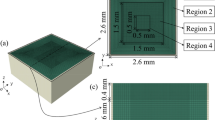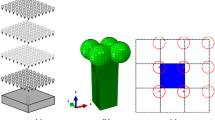Abstract
Shot peening is widely used in engineering as a classical strengthening process. Although many studies on shot peening have been done, most have focused on homogeneous target materials. In this paper, a theoretical model is proposed for predicting the surface morphology of inhomogeneous target materials. The topography of target materials after single-shot impact is calculated on the basis of energy conservation and Hertz contact theory, and the final three-dimensional surface topography after multiple-shot impact is obtained through superposition. Single-shot and random multiple-shot finite element models are used to show the advantages of the proposed model over the existing theoretical model for homogeneous target materials. The roughness is found to increase with the shot velocity and shot radius.












Similar content being viewed by others
Availability of data and material
All data generated or analyzed during this study are included in this published article.
References
Kovaci H, Bozkurt YB, Yetim AF, Aslan M, Celik A (2019) The effect of surface plastic deformation produced by shot peening on corrosion behavior of a low-alloy steel. Surf Coat Technol 360:78–86
Wang C, Li W, Jiang J, Chao X, Zeng W, Yang J (2021) Mechanical behavior study of asymmetric deformation in double-sided symmetrical sequential shot peening process. Int J Adv Manuf Tech 114:1189–1204
Chen F, Miao X, Tang Y, Yin S (2017) A review on recent advances in machining methods based on abrasive jet polishing (AJP). Int J Adv Manuf Tech 90(1–4):785–799
Bagherifard S, Guagliano M (2012) Fatigue behavior of a low-alloy steel with nanostructured surface obtained by severe shot peening. Eng Fract Mech 81:56–68
Dalaei K, Karlsson B (2012) Influence of shot peening on fatigue durability of normalized steel subjected to variable amplitude loading. Int J Fatigue 38:75–83
Miková K, Bagherifard S, Bokuvka O, Guagliano M, Trško L (2013) Fatigue behavior of X70 microalloyed steel after severe shot peening. Int J Fatigue 55:33–42
Kim J, Cheong S, Noguchi H (2013) Evolution of residual stress redistribution associated with localized surface microcracking in shot-peened medium-carbon steel during fatigue test. Int J Fatigue 55:147–157
Sherif HA (2004) Investigation on effect of surface topography of pad/disc assembly on squeal generation. Wear 257(7–8):687–695
Sherif HA (1991) Effect of contact stiffness on the establishment of self-excited vibrations. Wear 141(2):227–234
Keller J, Fridrici J, Kapsa P, Huard JF (2010) Effect of surface topography on friction and wear of cast iron for cylinder liners. In: Advanced tribology: proceedings of CIST2008 & ITS-IFToMM2008. Por Jianbin Luo, Yonggang Meng, Tianmin Shao, Qian Zhao. Springer; pp 447–448
Grabon W, Pawlus P, Wos S, Koszela W, Wieczorowski M (2018) Effects of cylinder liner surface topography on friction and wear of liner-ring system at low temperature. Tribol Int 121(1):148–160
Gao H (1991) Stress concentration at slightly undulating surfaces. J Mech Phys Solids 39(4):443–458
Yang L, Qu J (1993) Fracture mechanics parameters for cracks on a slightly undulating interface. Int J Fract 64(1):79–91
Xie HB, Jiang ZY, Yuen WYD (2011) Analysis of friction and surface roughness effects on edge crack evolution of thin strip during cold rolling. Tribol Int 44(9):971–979
Beaucamp A, Namba Y (2013) Super-smooth finishing of diamond turned hard X-ray molding dies by combined fluid jet and bonnet polishing. CIRP Ann-Manuf Technol 62(1):315–318
Beaucamp A, Namba Y, Messelink W, Walker D, Charlton P, Freeman R (2014) Surface integrity of fluid jet polished tungsten carbide. Procedia CIRP 13:377–381
Pham HL, Shiou F, Yu Z, Hsu W (2013) Investigation of optimal air- driving fluid jet polishing parameters for the surface finish of N-BK7 optical glass. J Manuf Sci E-T Asme 135(1):011–015
Tsai F, Yan B, Kuan C, Hsu R, Hung J (2009) An investigation into superficial embedment in mirror-like machining using abrasive jet polishing. Int J Adv Manuf Tech 43(5–6):500–512
Lin Q, Liu H, Zhu C, Parker RG (2019) Investigation on the effect of shot peening coverage on the surface integrity. Appl Surf Sci 489:66–72
Haj MJR, Spelt JK, Papini M (2013) Surface roughness and erosion rate of abrasive jet micro-machined channels: Experiments and analytical model. Wear 303:138–145
Wang Z, Li HN, Yu TB, Chen H, Zhao J (2019) On the predictive modelling of machined surface topography in abrasive air jet polishing of quartz glass. Int J Mech Sci 152:1–18
Wang Z, Li HN, Yu TB, Wang ZX, Zhao J (2019) Analytical model of dynamic and overlapped footprints in abrasive air jet polishing of optical glass. International J Mach Tools Manuf 141:59–77
Qu S, Wang ZX, Zhang C, Ma ZL, Zhang TQ, Chen H, Wang Z, Yu TB, Zhao J (2021) Material removal profile prediction and experimental validation for obliquely axial ultrasonic vibration-assisted polishing of K9 optical glass. Ceram Int 47:33106–33119
Zhang M, He Z, Zhang Y, Wang X, Zhao S, Fu T, Chen L (2019) Theoretical and finite element analysis of residual stress field for different geometrical features after abrasive waterjet peening. J Press Vess-T Asme 141(1):011401
Jiang Z, Wang P, Li D, Li Y (2019) Influence of the decomposition behavior of retained austenite during tempering on the mechanical properties of 2.25Cr-1Mo-0.25 V steel. Mat Sci Eng A-Struct 742:540–552
Markežič R, Mole N, Naglič I, Šturm R (2020) Time and temperature dependent softening of H11 hot-work tool steel and definition of an anisothermal tempering kinetic model. Mater Today Commun 22:100744
Jilg A, Seifert T (2018) Temperature dependent cyclic mechanical properties of a hot work steel after time and temperature dependent softening. Mat Sci Eng A-Struct 721:96–102
Popov VL (2010) Contact Mechanics and Friction Physical Principles and Applications. Springer
Thorton C (1997) Coefficient of restitution for collinear collisions of elastic- perfectly plastic spheres. J Appl Mech-T Asme 64(2):383–386
Miao HY, Larose S, Perron C, Lévesque M (2010) An analytical approach to relate shot peening parameters to Almen intensity. Surf Coat Tech 205(7):2055–2066
Xu G, Hao M, Qiao Y, Zhang Y, Wang G (2020) Characterization of elastic-plastic properties of surface-modified layers introduced by carburizing. Mech Mater 144:103364
Tabor D (1951) The Hardness of Metals. Clarendon Press, Oxford, UK
Pham TQ, Khun NW, Butler DL (2017) New approach to estimate coverage parameter in 3D FEM shot peening simulation. Surf Eng 33(9):687–695
Kirk D, Abyaneh MY (1995) Theoretical basis of shot peening coverage control. The Shot Peener 9(2):28–30
Bagherifard S, Ghelichi R, Guagliano M (2010) A numerical model of severe shot peening (SSP) to predict the generation of a nanostructured surface layer of material. Surf Coat Technol 204(24):4081–4090
Acknowledgements
This work has been supported by the National Natural Science Foundation of China (Nos. 12072324, U1804254), Important Science &Technology Specific Projects of Henan Province (No. 201400211200) and the Key Teachers Program for the University of Henan Province (No. 2019GGJS005).
Funding
National Natural Science Foundation of China (Nos. 12072324, U1804254).
Author information
Authors and Affiliations
Contributions
BingBing Wang: Conceptualization and Writing; HaiKuan Chen: Software and Formal analysis; GuangTao Xu: Writing-review and editing; JianWei Zhang: review and editing; MingHao Zhao: Conceptualization and Methodology.
Corresponding authors
Ethics declarations
Ethical approval
Not applicable.
Consent to participate
Not applicable.
Consent to publish
Not applicable.
Conflict of interest
The authors declare no competing interests.
Additional information
Publisher's Note
Springer Nature remains neutral with regard to jurisdictional claims in published maps and institutional affiliations.
Rights and permissions
About this article
Cite this article
Wang, B., Chen, H., Xu, G. et al. A theoretical model for predicting the surface topography of inhomogeneous materials after shot peening. Int J Adv Manuf Technol 119, 7533–7541 (2022). https://doi.org/10.1007/s00170-022-08677-4
Received:
Accepted:
Published:
Issue Date:
DOI: https://doi.org/10.1007/s00170-022-08677-4




